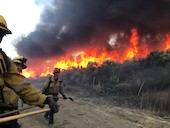Confronting Wildfire Season in 2020 - The New "New Normal"
 California continues to be in a drought of historic proportions – the worst megadrought in centuries. The state recorded less than half of the normal amount of rainfall and snow for the current time of year. Even without the COVID-19 outbreak, California’s firefighters would be bracing for a long, hot summer. The coronavirus has made a bad situation that much worse.
California continues to be in a drought of historic proportions – the worst megadrought in centuries. The state recorded less than half of the normal amount of rainfall and snow for the current time of year. Even without the COVID-19 outbreak, California’s firefighters would be bracing for a long, hot summer. The coronavirus has made a bad situation that much worse.
As the weather gets warmer and the wildfire risk rises, firefighters from throughout California will once again be deployed to meet the need, along with those from other states. In today’s COVID-19 circumstances, close proximity can give opportunity for the virus to spread from person to person; then, eventually spread to the localities that the firefighters came from.
“When we have firefighters falling ill, we’re not going to have personnel to respond appropriately to fires, said Tim Edwards, president of CAL FIRE Local 2881, in an interview with CNBC. “The fires will get bigger and more destructive.”
The coronavirus pandemic may also impact evacuations. More challenges can occur as people turn to shelters for housing. Shelters will have a lower capacity than normal because of social distancing guidelines. So, more facilities and more staffing will be required. Therefore, there will be new concerns for managing logistical issues for meal distribution, sleeping arrangements, and sanitation.
The pandemic has already created a potentially devastating strain on resources, both at the state and local levels. Governor Newsom proposed a budget for a variety of resources to help combat this season’s wildfires, including an 11 percent hike in CAL FIRE’s staffing and $500 million for fuel mitigation and fire prevention. However, the state’s estimated $7 billion response to the COVID-19 outbreak threatens to wipe out state budget reserves, and could put any funding increases at risk.
Meanwhile on the front lines, firefighters in fire camps face working and living conditions that allow for the possibility of contact with the virus. This is a direct threat to the health and safety of firefighters as well as potentially impacting fire response.
“Our concern is how to set up a base camp and maintain feeding and cleanliness in an area with 1,000 firefighters sitting on only five acres of land,” said Edwards. “If one or two firefighters are infected, social distancing is hard.”
CPF has been engaged with both Cal-OES and the Newsom Administration to ensure that the issues facing frontline firefighters are front and center.
“We’ve been in close contact with all of the major players from the beginning,” said CPF President Brian Rice. “We’re committed to making sure that firefighters already putting their lives at risk fighting major fires are not also put at risk from yet another unseen threat while doing their duty.”